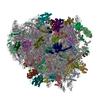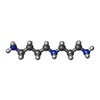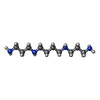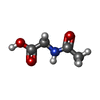+ Open data
Open data
- Basic information
Basic information
| Entry | Database: PDB / ID: 8p2k | |||||||||||||||
|---|---|---|---|---|---|---|---|---|---|---|---|---|---|---|---|---|
| Title | Ternary complex of translating ribosome, NAC and METAP1 | |||||||||||||||
 Components Components |
| |||||||||||||||
 Keywords Keywords | TRANSLATION / ribosome / methionine aminopeptidase 1 / methionine excision / protein biogenesis / nascent chain | |||||||||||||||
| Function / homology |  Function and homology information Function and homology informationnegative regulation of protein localization to endoplasmic reticulum / nascent polypeptide-associated complex / regulation of skeletal muscle fiber development / negative regulation of striated muscle cell apoptotic process / positive regulation of cell proliferation involved in heart morphogenesis / positive regulation of skeletal muscle tissue growth / cardiac ventricle development / glucose-6-phosphate isomerase / glucose-6-phosphate isomerase activity / N-terminal protein amino acid modification ...negative regulation of protein localization to endoplasmic reticulum / nascent polypeptide-associated complex / regulation of skeletal muscle fiber development / negative regulation of striated muscle cell apoptotic process / positive regulation of cell proliferation involved in heart morphogenesis / positive regulation of skeletal muscle tissue growth / cardiac ventricle development / glucose-6-phosphate isomerase / glucose-6-phosphate isomerase activity / N-terminal protein amino acid modification / hemostasis / peptidyl-methionine modification / skeletal muscle tissue regeneration / glucose 6-phosphate metabolic process / initiator methionyl aminopeptidase activity / heart trabecula morphogenesis / ribosomal subunit / carbohydrate derivative binding / methionyl aminopeptidase / metalloexopeptidase activity / negative regulation of RNA splicing / Gluconeogenesis / monosaccharide binding / protein targeting to membrane / Glycolysis / erythrocyte homeostasis / laminin receptor activity / regulation of G1 to G0 transition / exit from mitosis / ciliary membrane / positive regulation of intrinsic apoptotic signaling pathway in response to DNA damage by p53 class mediator / regulation of translation involved in cellular response to UV / protein-DNA complex disassembly / positive regulation of immunoglobulin production / positive regulation of DNA damage response, signal transduction by p53 class mediator resulting in transcription of p21 class mediator / optic nerve development / mammalian oogenesis stage / retinal ganglion cell axon guidance / G1 to G0 transition / activation-induced cell death of T cells / response to testosterone / Peptide chain elongation / organelle membrane / Selenocysteine synthesis / positive regulation of signal transduction by p53 class mediator / metalloaminopeptidase activity / ubiquitin ligase inhibitor activity / Formation of a pool of free 40S subunits / phagocytic cup / Eukaryotic Translation Termination / humoral immune response / Response of EIF2AK4 (GCN2) to amino acid deficiency / SRP-dependent cotranslational protein targeting to membrane / protein maturation / Nonsense Mediated Decay (NMD) independent of the Exon Junction Complex (EJC) / Viral mRNA Translation / mesoderm formation / response to immobilization stress / L13a-mediated translational silencing of Ceruloplasmin expression / GTP hydrolysis and joining of the 60S ribosomal subunit / endonucleolytic cleavage to generate mature 3'-end of SSU-rRNA from (SSU-rRNA, 5.8S rRNA, LSU-rRNA) / TOR signaling / T cell proliferation involved in immune response / Major pathway of rRNA processing in the nucleolus and cytosol / protein-RNA complex assembly / Nonsense Mediated Decay (NMD) enhanced by the Exon Junction Complex (EJC) / ribosomal small subunit export from nucleus / erythrocyte development / translation regulator activity / cellular response to actinomycin D / cytosolic ribosome / response to cadmium ion / aminopeptidase activity / laminin binding / rough endoplasmic reticulum / endonucleolytic cleavage in ITS1 to separate SSU-rRNA from 5.8S rRNA and LSU-rRNA from tricistronic rRNA transcript (SSU-rRNA, 5.8S rRNA, LSU-rRNA) / gastrulation / MDM2/MDM4 family protein binding / DNA damage response, signal transduction by p53 class mediator resulting in cell cycle arrest / response to muscle stretch / class I DNA-(apurinic or apyrimidinic site) endonuclease activity / DNA-(apurinic or apyrimidinic site) lyase / negative regulation of ubiquitin-dependent protein catabolic process / rescue of stalled ribosome / positive regulation of endothelial cell migration / maturation of LSU-rRNA from tricistronic rRNA transcript (SSU-rRNA, 5.8S rRNA, LSU-rRNA) / 90S preribosome / maturation of SSU-rRNA from tricistronic rRNA transcript (SSU-rRNA, 5.8S rRNA, LSU-rRNA) / maturation of LSU-rRNA / ribosomal large subunit biogenesis / cellular response to leukemia inhibitory factor / maturation of SSU-rRNA / cytokine activity / positive regulation of translation / gluconeogenesis / response to progesterone / glycolytic process / TP53 Regulates Metabolic Genes / small-subunit processome / positive regulation of apoptotic signaling pathway Similarity search - Function | |||||||||||||||
| Biological species |   Homo sapiens (human) Homo sapiens (human) | |||||||||||||||
| Method | ELECTRON MICROSCOPY / single particle reconstruction / cryo EM / Resolution: 2.9 Å | |||||||||||||||
 Authors Authors | Jia, M. / Jaskolowski, M. / Scaiola, A. / Jomaa, A. / Ban, N. | |||||||||||||||
| Funding support |  Switzerland, Switzerland,  Germany, 4items Germany, 4items
| |||||||||||||||
 Citation Citation |  Journal: Science / Year: 2023 Journal: Science / Year: 2023Title: NAC controls cotranslational N-terminal methionine excision in eukaryotes. Authors: Martin Gamerdinger / Min Jia / Renate Schloemer / Laurenz Rabl / Mateusz Jaskolowski / Katrin M Khakzar / Zeynel Ulusoy / Annalena Wallisch / Ahmad Jomaa / Gundula Hunaeus / Alain Scaiola / ...Authors: Martin Gamerdinger / Min Jia / Renate Schloemer / Laurenz Rabl / Mateusz Jaskolowski / Katrin M Khakzar / Zeynel Ulusoy / Annalena Wallisch / Ahmad Jomaa / Gundula Hunaeus / Alain Scaiola / Kay Diederichs / Nenad Ban / Elke Deuerling /   Abstract: N-terminal methionine excision from newly synthesized proteins, catalyzed cotranslationally by methionine aminopeptidases (METAPs), is an essential and universally conserved process that plays a key ...N-terminal methionine excision from newly synthesized proteins, catalyzed cotranslationally by methionine aminopeptidases (METAPs), is an essential and universally conserved process that plays a key role in cell homeostasis and protein biogenesis. However, how METAPs interact with ribosomes and how their cleavage specificity is ensured is unknown. We discovered that in eukaryotes the nascent polypeptide-associated complex (NAC) controls ribosome binding of METAP1. NAC recruits METAP1 using a long, flexible tail and provides a platform for the formation of an active methionine excision complex at the ribosomal tunnel exit. This mode of interaction ensures the efficient excision of methionine from cytosolic proteins, whereas proteins targeted to the endoplasmic reticulum are spared. Our results suggest a broader mechanism for how access of protein biogenesis factors to translating ribosomes is controlled. | |||||||||||||||
| History |
|
- Structure visualization
Structure visualization
| Structure viewer | Molecule:  Molmil Molmil Jmol/JSmol Jmol/JSmol |
|---|
- Downloads & links
Downloads & links
- Download
Download
| PDBx/mmCIF format |  8p2k.cif.gz 8p2k.cif.gz | 7.1 MB | Display |  PDBx/mmCIF format PDBx/mmCIF format |
|---|---|---|---|---|
| PDB format |  pdb8p2k.ent.gz pdb8p2k.ent.gz | Display |  PDB format PDB format | |
| PDBx/mmJSON format |  8p2k.json.gz 8p2k.json.gz | Tree view |  PDBx/mmJSON format PDBx/mmJSON format | |
| Others |  Other downloads Other downloads |
-Validation report
| Summary document |  8p2k_validation.pdf.gz 8p2k_validation.pdf.gz | 2.4 MB | Display |  wwPDB validaton report wwPDB validaton report |
|---|---|---|---|---|
| Full document |  8p2k_full_validation.pdf.gz 8p2k_full_validation.pdf.gz | 2.6 MB | Display | |
| Data in XML |  8p2k_validation.xml.gz 8p2k_validation.xml.gz | 391.2 KB | Display | |
| Data in CIF |  8p2k_validation.cif.gz 8p2k_validation.cif.gz | 660.5 KB | Display | |
| Arichive directory |  https://data.pdbj.org/pub/pdb/validation_reports/p2/8p2k https://data.pdbj.org/pub/pdb/validation_reports/p2/8p2k ftp://data.pdbj.org/pub/pdb/validation_reports/p2/8p2k ftp://data.pdbj.org/pub/pdb/validation_reports/p2/8p2k | HTTPS FTP |
-Related structure data
| Related structure data |  17367MC M: map data used to model this data C: citing same article ( |
|---|---|
| Similar structure data | Similarity search - Function & homology  F&H Search F&H Search |
- Links
Links
- Assembly
Assembly
| Deposited unit | 
|
|---|---|
| 1 |
|
- Components
Components
-RNA chain , 6 types, 6 molecules B5B7B8A2AIAT
| #1: RNA chain | Mass: 1557519.500 Da / Num. of mol.: 1 / Source method: isolated from a natural source / Source: (natural)  |
|---|---|
| #2: RNA chain | Mass: 38691.914 Da / Num. of mol.: 1 / Source method: isolated from a natural source / Source: (natural)  |
| #3: RNA chain | Mass: 50809.047 Da / Num. of mol.: 1 / Source method: isolated from a natural source / Source: (natural)  |
| #52: RNA chain | Mass: 603928.250 Da / Num. of mol.: 1 / Source method: isolated from a natural source / Source: (natural)  |
| #60: RNA chain | Mass: 15209.544 Da / Num. of mol.: 1 / Source method: isolated from a natural source / Source: (natural)  |
| #61: RNA chain | Mass: 24451.561 Da / Num. of mol.: 1 / Source method: isolated from a natural source / Source: (natural)  |
+60S ribosomal protein ... , 28 types, 28 molecules BABCBEBGBHBIBJBLBMBOBSBTBUBZBaBbBcBdBfBgBhBiBkBlBpBrBtAz
-Ribosomal protein ... , 14 types, 14 molecules BBBDBFBNBRBVBWBYBeBjBvACAeAv
| #5: Protein | Mass: 46120.996 Da / Num. of mol.: 1 / Source method: isolated from a natural source / Source: (natural)  |
|---|---|
| #7: Protein | Mass: 34509.879 Da / Num. of mol.: 1 / Source method: isolated from a natural source / Source: (natural)  |
| #9: Protein | Mass: 29201.836 Da / Num. of mol.: 1 / Source method: isolated from a natural source / Source: (natural)  |
| #17: Protein | Mass: 24207.285 Da / Num. of mol.: 1 / Source method: isolated from a natural source / Source: (natural)  |
| #21: Protein | Mass: 23535.281 Da / Num. of mol.: 1 / Source method: isolated from a natural source / Source: (natural)  |
| #25: Protein | Mass: 14892.505 Da / Num. of mol.: 1 / Source method: isolated from a natural source / Source: (natural)  |
| #26: Protein | Mass: 17825.111 Da / Num. of mol.: 1 / Source method: isolated from a natural source / Source: (natural)  |
| #28: Protein | Mass: 17303.363 Da / Num. of mol.: 1 / Source method: isolated from a natural source / Source: (natural)  |
| #34: Protein | Mass: 15898.932 Da / Num. of mol.: 1 / Source method: isolated from a natural source / Source: (natural)  |
| #39: Protein | Mass: 11111.032 Da / Num. of mol.: 1 / Source method: isolated from a natural source / Source: (natural)  |
| #48: Protein | Mass: 24875.410 Da / Num. of mol.: 1 / Source method: isolated from a natural source / Source: (natural)  |
| #55: Protein | Mass: 18004.041 Da / Num. of mol.: 1 / Source method: isolated from a natural source / Source: (natural)  |
| #67: Protein | Mass: 22913.453 Da / Num. of mol.: 1 / Source method: isolated from a natural source / Source: (natural)  |
| #84: Protein | Mass: 14865.555 Da / Num. of mol.: 1 / Source method: isolated from a natural source / Source: (natural)  |
-Protein , 14 types, 14 molecules BKBPBQBXBmBoBsMANaNbAEAFAjAp
| #14: Protein | Mass: 7967.228 Da / Num. of mol.: 1 Source method: isolated from a genetically manipulated source Source: (gene. exp.)   |
|---|---|
| #19: Protein | Mass: 21444.221 Da / Num. of mol.: 1 / Source method: isolated from a natural source / Source: (natural)  |
| #20: Protein | Mass: 21699.688 Da / Num. of mol.: 1 / Source method: isolated from a natural source / Source: (natural)  |
| #27: Protein | Mass: 17768.246 Da / Num. of mol.: 1 / Source method: isolated from a natural source / Source: (natural)  |
| #42: Protein | Mass: 14800.474 Da / Num. of mol.: 1 / Source method: isolated from a natural source / Source: (natural)  |
| #43: Protein | Mass: 12489.991 Da / Num. of mol.: 1 / Source method: isolated from a natural source / Source: (natural)  |
| #46: Protein | Mass: 34380.504 Da / Num. of mol.: 1 / Source method: isolated from a natural source / Source: (natural)  |
| #49: Protein | Mass: 43274.195 Da / Num. of mol.: 1 Source method: isolated from a genetically manipulated source Source: (gene. exp.)  Homo sapiens (human) / Gene: METAP1, KIAA0094 / Production host: Homo sapiens (human) / Gene: METAP1, KIAA0094 / Production host:  |
| #50: Protein | Mass: 23406.824 Da / Num. of mol.: 1 Source method: isolated from a genetically manipulated source Source: (gene. exp.)  Homo sapiens (human) / Gene: NACA, HSD48 / Production host: Homo sapiens (human) / Gene: NACA, HSD48 / Production host:  |
| #51: Protein | Mass: 14493.821 Da / Num. of mol.: 1 Source method: isolated from a genetically manipulated source Source: (gene. exp.)  Homo sapiens (human) / Gene: BTF3 / Production host: Homo sapiens (human) / Gene: BTF3 / Production host:  |
| #57: Protein | Mass: 13047.532 Da / Num. of mol.: 1 / Source method: isolated from a natural source / Source: (natural)  |
| #58: Protein | Mass: 35115.652 Da / Num. of mol.: 1 / Source method: isolated from a natural source / Source: (natural)  |
| #72: Protein | Mass: 18933.846 Da / Num. of mol.: 1 / Source method: isolated from a natural source / Source: (natural)  |
| #78: Protein | Mass: 19213.465 Da / Num. of mol.: 1 / Source method: isolated from a natural source / Source: (natural)  |
+40S ribosomal protein ... , 26 types, 26 molecules AAABADAGAZAaAbAcAdAfAgAhAiAkAlAmAnAoAqArAsAtAuAwAxAy
-Non-polymers , 9 types, 2965 molecules 
















| #89: Chemical | ChemComp-N / #90: Chemical | ChemComp-SPD / #91: Chemical | #92: Chemical | ChemComp-MG / #93: Chemical | ChemComp-UNX / #94: Chemical | ChemComp-GTP / | #95: Chemical | ChemComp-AAC / | #96: Chemical | ChemComp-ZN / #97: Water | ChemComp-HOH / | |
|---|
-Details
| Has ligand of interest | N |
|---|
-Experimental details
-Experiment
| Experiment | Method: ELECTRON MICROSCOPY |
|---|---|
| EM experiment | Aggregation state: PARTICLE / 3D reconstruction method: single particle reconstruction |
- Sample preparation
Sample preparation
| Component |
| ||||||||||||||||||||||||
|---|---|---|---|---|---|---|---|---|---|---|---|---|---|---|---|---|---|---|---|---|---|---|---|---|---|
| Source (natural) |
| ||||||||||||||||||||||||
| Source (recombinant) |
| ||||||||||||||||||||||||
| Buffer solution | pH: 7.6 | ||||||||||||||||||||||||
| Specimen | Embedding applied: NO / Shadowing applied: NO / Staining applied: NO / Vitrification applied: YES | ||||||||||||||||||||||||
| Specimen support | Grid material: COPPER / Grid type: Quantifoil R2/2 | ||||||||||||||||||||||||
| Vitrification | Instrument: FEI VITROBOT MARK IV / Cryogen name: ETHANE-PROPANE / Humidity: 100 % / Chamber temperature: 277.15 K |
- Electron microscopy imaging
Electron microscopy imaging
| Experimental equipment |  Model: Titan Krios / Image courtesy: FEI Company |
|---|---|
| Microscopy | Model: FEI TITAN KRIOS |
| Electron gun | Electron source:  FIELD EMISSION GUN / Accelerating voltage: 300 kV / Illumination mode: SPOT SCAN FIELD EMISSION GUN / Accelerating voltage: 300 kV / Illumination mode: SPOT SCAN |
| Electron lens | Mode: BRIGHT FIELD / Nominal magnification: 81000 X / Nominal defocus max: 2400 nm / Nominal defocus min: 600 nm |
| Specimen holder | Cryogen: NITROGEN / Specimen holder model: FEI TITAN KRIOS AUTOGRID HOLDER |
| Image recording | Electron dose: 60 e/Å2 / Film or detector model: GATAN K3 (6k x 4k) |
- Processing
Processing
| Software |
| ||||||||||||||||||||||||||||
|---|---|---|---|---|---|---|---|---|---|---|---|---|---|---|---|---|---|---|---|---|---|---|---|---|---|---|---|---|---|
| EM software |
| ||||||||||||||||||||||||||||
| CTF correction | Type: PHASE FLIPPING AND AMPLITUDE CORRECTION | ||||||||||||||||||||||||||||
| 3D reconstruction | Resolution: 2.9 Å / Resolution method: FSC 0.143 CUT-OFF / Num. of particles: 21221 / Algorithm: FOURIER SPACE / Symmetry type: POINT | ||||||||||||||||||||||||||||
| Atomic model building | Protocol: RIGID BODY FIT / Space: REAL | ||||||||||||||||||||||||||||
| Atomic model building |
| ||||||||||||||||||||||||||||
| Refinement | Cross valid method: NONE Stereochemistry target values: GeoStd + Monomer Library + CDL v1.2 | ||||||||||||||||||||||||||||
| Displacement parameters | Biso mean: 115.48 Å2 | ||||||||||||||||||||||||||||
| Refine LS restraints |
|
 Movie
Movie Controller
Controller






 PDBj
PDBj


















































